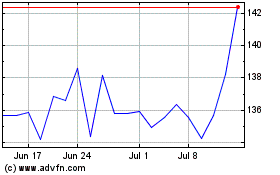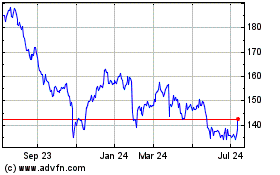U.S. Postal Service Swings to Profit -- Update
February 09 2016 - 5:28PM
Dow Jones News
By Laura Stevens
The U.S. Postal Service on Tuesday posted its first quarterly
profit since 2011, earning $307 million after a holiday delivery
season that beat expectations due in part to more flexibility on
hiring seasonal workers from its unions.
Excluding special items, such as prepaying retiree health
benefits and certain changes in workers' compensation expenses,
controllable income increased 12% to $1.26 billion for the quarter
ended Dec. 31.
The USPS this holiday season was looking to elbow its way
further into an e-commerce market long dominated by United Parcel
Service Inc. and FedEx Corp. And for the first time in recent
years, the USPS delivered more packages than both of those rivals,
as the agency exceeded its holiday predictions.
Letter carriers delivered about 660 million packages over the
holidays, up from the agency's initial forecast of about 600
million. UPS delivered 612 million packages, under its forecast of
630 million deliveries.
"The Postal Service, I believe, is uniquely positioned to flex
up during a period when you have such a surge in volume. We kept
our network fluid, and we delivered value for our customers," said
Postmaster General Megan Brennan on an earnings conference call
with journalists.
Keeping packages flowing meant the Postal Service hired about
30,000 seasonal workers and increased the number of delivery shifts
in some areas to three a day from one. It also ran the equivalent
of as many as 25,000 routes on Sunday, up from 4,000 on a normal
Sunday.
But packages are more labor intensive than letters -- often
requiring a letter carrier to walk to the door -- and costs
increased. Total work hours were up 3%, or 8 million, compared with
the same quarter a year ago, due to 16% more packages. Compensation
increased less, up 2% to $9.74 billion.
Ms. Brennan said the agency is working to control costs through
implementing more technology, including routing software for
deliveries. In addition, the unions have given the agency more
power to hire seasonal and other temporary workers. About 20% of
its workforce nationwide is currently considered flexible, she
said.
"In negotiations with our respective unions, we've increased our
flexibility, and they've worked very closely with us to enable us
to have the ability to flex up and to look at utilizing these
additional flexible resources at a lower wage rate," Ms. Brennan
said.
A spokeswoman for the American Postal Workers Union said that
the unions' agreement on flexible hiring is for three years and
runs through May 2018.
Transportation costs rose by $82 million, to $1.88 billion in
the quarter, also due to more packages, the agency said.
The way the USPS prices packages and allocates those costs has
long been an issue for UPS and FedEx, both of which compete with
the agency for packages, and also use their low-cost delivery
option to transport packages the so-called last mile from a local
post office to the door. The delivery giants have previously
challenged the agency's calculations. Most recently, UPS has
proposed a new method for determining costs for packages, which
would likely result in higher prices.
"Although UPS supports a healthy and viable Postal Service, we
are concerned that the USPS is forcing monopoly mailers, primarily
users of letter mail, to bear the burden of costs to deliver
parcels. This violates U.S. law, and needs to be addressed by the
Postal Regulatory Commission and Congress," a UPS spokeswoman added
in a statement.
Over all, the Postal Service reported a profit of $307 million,
compared with a year earlier loss of $754 million. Excluding the
favorable impact of interest rate changes and the effect of a
certain surcharge, the Postal Service's loss would have been $700
million. Operating revenue rose 3.3% to $19.35 billion.
The Postal Service doesn't receive taxpayer dollars to cover
operating costs, although it is compensated for certain services
and has used up a $15 billion credit line with the U.S. Department
of the Treasury.
The Postal Service will continue to work to get postal reform
legislation passed to relieve some of the financial pressure on the
organization, especially the prefunding of retiree benefits, Ms.
Brennan added.
"We need legislation now," Ms. Brennan said. "Absent that, our
financial condition worsens."
Tess Stynes contributed to this article.
Write to Laura Stevens at laura.stevens@wsj.com
(END) Dow Jones Newswires
February 09, 2016 17:13 ET (22:13 GMT)
Copyright (c) 2016 Dow Jones & Company, Inc.
United Parcel Service (NYSE:UPS)
Historical Stock Chart
From Mar 2024 to Apr 2024

United Parcel Service (NYSE:UPS)
Historical Stock Chart
From Apr 2023 to Apr 2024
